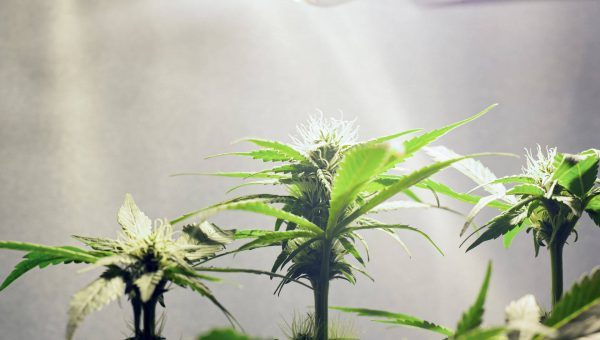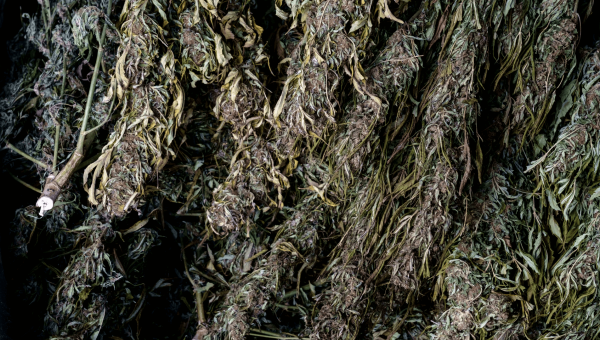Cannabis growers are always searching for ways to maximize their yields. To achieve that, two types of training techniques can be employed: low-stress training (LST) and high-stress training (HST).
LST is less harsh since it does not entail injuring any parts of the plant. Meanwhile, HST involves hurting the plant, so it is riskier to perform. Nevertheless, with practice, you can get impressive yields if you get it right.
One popular form of HST is super cropping. In fact, it is one of the oldest and most commonly used tactics in training cannabis due to its simplicity. If you want to learn more about this technique, continue reading below.

What is Super Cropping?
Super cropping is a type of high-stress training (HST) technique wherein you stress the plant by hurting it in a planned way. It could mean breaking certain parts of the plant before it reaches the flowering stage to encourage it to distribute a growth repair hormone through its entire body.
When the plant’s cell walls are purposely damaged, it will result in a solid wooden knuckle forming around the breaking point. It can lead to more buds, bushier plants, and more potent weed. Think of it as breaking a bone; the weakest part becomes calcified to make the whole bone stronger.
This technique should only be performed by growers who are familiar with plant training and understand the plant’s condition during the process. It is very easy to make mistakes, but done properly, it can make a huge difference to how well your plants grow.
Fortunately, with the right tips and extra patience, even novice growers can harvest the rewards of super cropping their marijuana plants. In this post, we’ll cover the steps on how to do it, as well as when and why to do it.
The Importance of Super Cropping Cannabis
Marijuana plants make resin to protect themselves from predators. The resin contains lots of substances, including cannabinoids and THC. The more resin a plant produces, the better off the plant is. Moreover, marijuana cultivators love resinous buds because they are more potent.
How does this happen? The buds and leaves of each plant have thousands of minuscule glands that produce resin. The heat from sunlight softens this substance, allowing it to pour all over the leaves and buds. This resin protects the plant against pests, dehydration, and low temperatures. When you learn how to damage the plant without hurting it badly, you can benefit from more resinous buds.
The main reason to engage in super cropping is to bump up the yield and enjoy weed with a higher THC concentration. However, some growers also use this technique to encourage the plant to grow broader and make use of light efficiently. Super cropping makes the plant grow laterally, creating a larger surface area. This is an excellent tactic if you have many plants.
Most growers use super cropping when they have limited vertical space or their plants are too close to the light. Therefore, it is a great strategy for Sativa strains.
The Best Time to Super Crop Cannabis
If you are a novice cannabis cultivator, we recommend employing this HST technique during the late vegetative stage, around 3 to 7 days before you switch to flowering. It will give them ample time to recover from stress before they start focusing their energy on bud production.
Avoid super cropping plants that are dealing with pest infestations, nutrient deficiencies, and other types of stress. Since super cropping by itself is already a stressful technique, you want your plants to be super healthy first so that they can cope with it.
For growers with intermediate knowledge of training marijuana, we suggest super cropping within the first two weeks of flowering, when the plant goes through its final period of explosive growth known as stretching. After super cropping, allow your plant to recover and feed/water it regularly. You will know that it is done correctly when you notice an increase in bud sites along the cropped branches.
Once you have become familiar with this technique, you can super crop in different ways throughout the plant’s life. Some growers even employ super cropping during the early vegetative phase to encourage rapid and robust growth.
If you are only using super cropping to increase the plant’s stability, do it as soon as the plant grows its third node. Combine it with LST, and you will get a bigger and stronger plant that is ready to support the weight of even the heaviest colas.
Or, you can use super cropping during the late vegetative up to the early flowering phase if you want to balance your canopy and bump up bud production for a bigger, more aromatic, and more potent yield.
Pros and Cons of Super Cropping
- It does not require much equipment.
- It results in higher yields and potency.
- It is ideal for Sativa-dominant plants.
- It is quick and easy.
- The recovery time is slow.
- It can create a possible site for infection.
- Any damage to the plant can be costly.
How Do You Super Crop Cannabis Plants?
Before you begin, here are the following things you will need:
- Soft plant ties (or anything that can be used to tie down branches that is not sharp)
- Duct tape
- Your fingers
Super cropping is a process that entails crushing the stem tissue so it can be bent easily. If you try to bend a branch before softening it, you will risk breaking and snapping it. The main goal here is to bend the branches just below the flower cluster. Here is a quick guide on how to do it:
1. Choose your branches.
The first thing you need to do is find the most bendable branches. Aim for the green parts instead of the older and firmer ones at the bottom of the stalk. If your plant already has several colas, you can super crop the main site of the colas. On the other hand, if it has a single cola, you should choose the greener growth near the top.
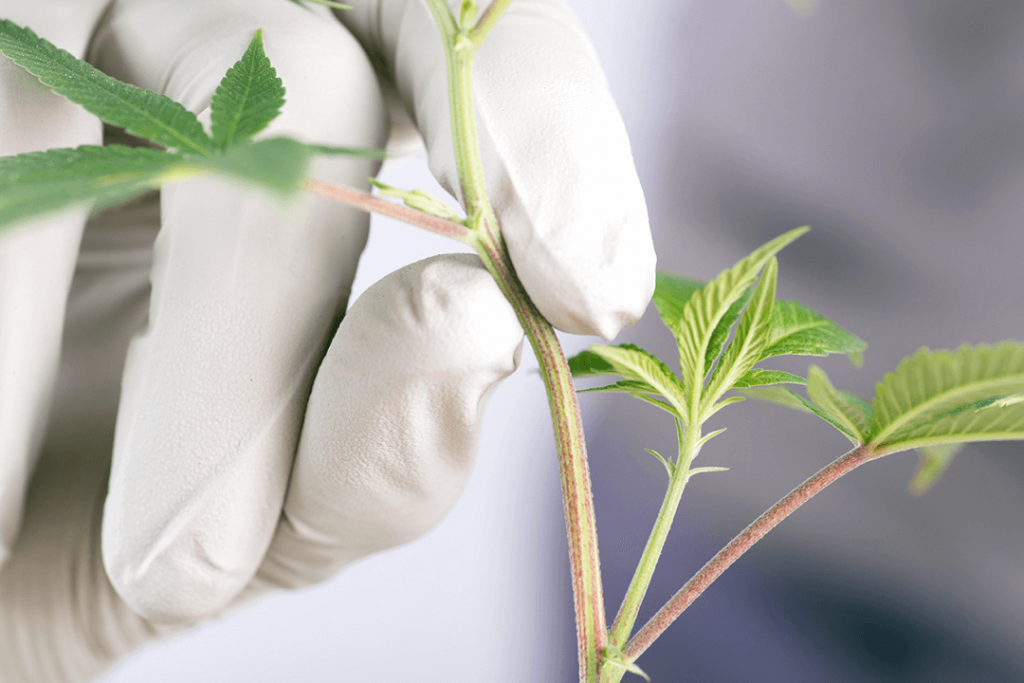
2. Firmly squeeze, then bend the branches.
The goal here is to damage the plant’s inner tissue without hurting the exterior. This will make the stem easier to bend. Grab the branch and squeeze it between your forefinger and thumb, then wiggle it between your fingers for around 10 seconds. Keep applying the same pressure until the inside of the stem feels softer.
Afterward, you can bend it in the direction you want. If the stem still feels stiff, you will need to squeeze and shake it up for a minute until it feels almost ready to snap.
Use a plant tie to secure it properly, or it will just go back to its original shape after a few hours.
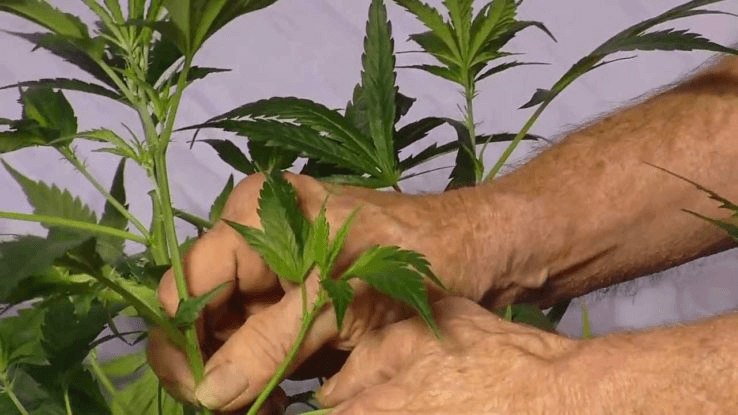
3. Treat any damage.
If you are just a beginner, you will not have to worry about minor damage in general. However, you will need duct tape to reinforce the plant and help it to heal if you see a crack or slit on the exterior of the stem.
But even if you do not crack the stem, securing it with the use of duct tape is advised. The original site of the bend will then grow a large knot that can carry more nutrients and water.

4. Remove the tape.
After 7 days, you can remove the tape. If you see discoloration in the healing area, don’t fret – this is just normal. That said, if the site has a gray hue and looks damaged, you must put the tape back until you see the protective knot grow.
Also, if you notice that some branches are trying to straighten, you can tie them down with tape. As long as your plant has the tape in the correct position, it will continue to absorb water and nutrients.
You can also watch this video for the step-by-step procedure of super cropping.
What Are the Other Forms of HST Techniques?
Aside from super cropping, here are other HST techniques you can try:
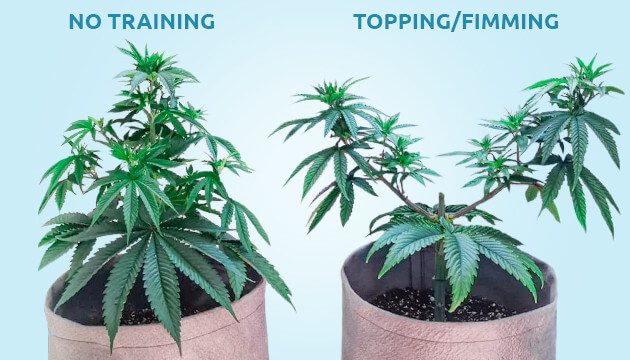
Topping
Topping is considered one of the easiest forms of plant training and is highly recommended for beginners. With topping, all you need to do is snip off the dominant shoot. The next 2 nodes below will receive all the energy from that main shoot you topped. Later, you can top those two shoots again, resulting in 4 shoots of new growth. You will then have 4 main colas that will turn into dense, potent flowers.
Fimming
Fimming is like a topping but with a twist. When you fim, the plant will recover faster since there is less damage to repair. Instead of removing the top of the plant completely, you remove new growth while avoiding any cuts between the nodes. Another advantage of fimming is it can generate 4 colas with each fim, compared to 2 colas per top.
Defoliation
Defoliation means removing fan leaves from your plant. It serves a few different purposes, such as allowing the light to go deeper into the plant since fan leaves can get pretty big and cover the flowering sites. It also helps your plant focus energy on branching, lateral growth, and flower development instead of producing lush, bushy foliage.
FAQs
Can you super crop during flowering?
In general, you should not super crop during flowering because you might end up causing more harm than good. During the flowering phase, you want your plant to spend all its energy on bud production, not repairing damaged tissues.
Moreover, you are more likely to end up snapping a branch as your plant gets older because they are tough and woody. It will have a lower chance of healing itself before harvest, resulting in a lower yield.
How long after super cropping can you begin the flowering stage?
After super cropping, you should wait at least 2 weeks before switching to flowering. This will give your plant sufficient time to recover and repair itself. Though stressing your plant can be a good thing, the act of switching from 18/6 to 12/12 is already stressful as it is.
Can you super crop autoflowering plants?
Since autoflowers grow quickly, some growers hesitate to perform super cropping on them. But if you have an idea of how long you have until your plants start flowering (since most autoflowering variants have a general timeline, whether Indica or Sativa), you can still use this technique.
You just have to be careful about your timing while making sure not to break any branches.
How many times can you super crop a plant?
Beginner growers can perform super cropping during the late vegetative stage. Advanced growers, on the other hand, can do it multiple times, such as during early vegetation and the start of flowering.
Keep in mind that this process does not stunt growth. Still, you should wait a bit for the plant to recover before starting again.
Final Thoughts
To sum up, here’s how to do super cropping:
- Choose the branch you want to super crop.
- Pinch it firmly between your thumb and forefinger and wiggle it until it gets pliable.
- Bend the branch carefully into the desired position and tie it down as necessary.
- Manage any damage with duct tape.
The main benefit of super cropping your cannabis is to increase resin production for more potent buds. It is also useful if you do not have much vertical space or just trying to grow discreetly. Though there are a few downsides, it is easy to perform once you get the hang of it.
